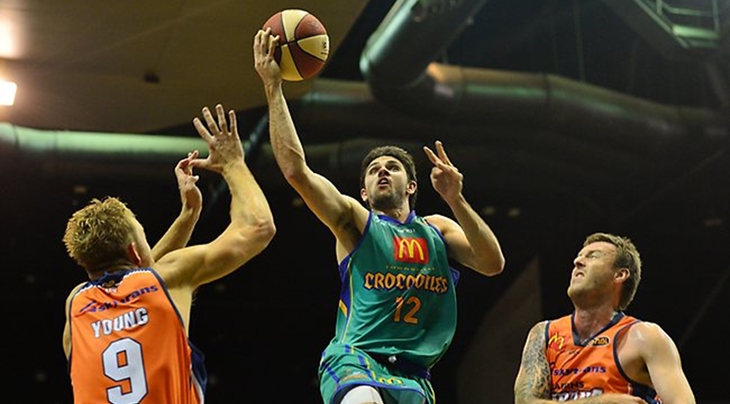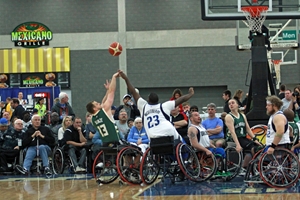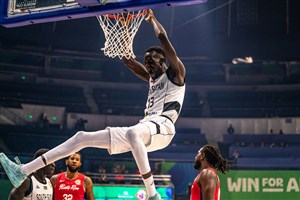
Asia won’t work without investment at home
MELBOURNE (Paulo Kennedy’s View from Downunder) – The NBL and Basketball Australia need to closely examine the potential impacts of the NBL’s salary system changes or there could be some significant long-term consequences.
The first ramifications from those changes were felt this week with the Townsville Crocodiles pulling out of the competition. No doubt the main reason for the Crocs’ departure was their inability to recapture local support, but the straw that broke the camel’s back was the new salary rules.
The Crocs reportedly spent $850,000 of the $1 million salary cap last season, but with new rules requiring teams spend at least $990,000 in 2016-17 the squeeze came. Cynics would suggest it was a strategic move by the NBL to force the hand of its weakest club.
Never count out the men in green! #HardBall @TsvCrocs @Adelaide36ers https://t.co/3l5APtcCk6
— NBL (@NBL) December 10, 2015
The main practical impact is eight or nine less jobs for Australian players. That figure is likely to sit in the low 50s this season, and there’s a good chance that figure will decrease in the near future too.
According to the NBL, their salary cap will now be set by the average amount clubs spent in the previous season. Given the spending power of Melbourne, Perth, New Zealand and now Sydney and Brisbane, that average is almost certain to be well above the 2016-17 soft cap of $1.1 million.
That means clubs like Cairns and Illawarra will be forced to spend over a million dollars on players in the very near future, and you have to wonder how that will be sustainable in their small markets without a significant dividend from the league.
With NBL boss Larry Kestelman firmly setting his sights on expansion into Asia, it would be no surprise to see as few as five or six Australian teams before long, with the focus on high-spending, high-quality rosters competing against big money clubs from Asian basketball powerhouses like China and the Philippines.
That direction has some financial merit. Why battle hard to keep Australian clubs afloat that don’t add commercial value to the league when you can focus on a streamlined product that appeals to a much larger pool of corporate dollars.
Of course, to wow countries like China and the Philippines your basketball product has to be spot on. So Kestelman wants teams packed with the best talent non-NBA from Australia and New Zealand and quality athletic imports who provide spectacular highlights.
Warrick's Monster Jam! #Hardball @Adelaide36ers @MelbUnitedHQ https://t.co/G3O0l1XQa3
— NBL (@NBL) December 23, 2015
Given the NBL’s failure to capture a large chunk of the Australian market this seems like a theory worth pursuing, but it can’t be done in isolation from the rest of the sport in this country.
Basketball is already a very poor option for talented young athletes choosing a sport to focus on because of the lack of professional jobs, and any further erosion could start to have an impact on the Boomers next decade.
BA need to find a way to invest in the second tier, a place where young Australian talent can hone their skills and increase their chances of securing a rare NBL contract. Maybe that can be through improving the current SEABL set-up, or maybe it has to be through a new initiative. The issue is, of course, funding.
Perhaps the most relevant source of investment is the NBL. Why would a league focused on Asia be interested in this, you ask? Because to be a high-level league you have to produce high-level talent, and NBL history tells us a lack of investment in the future leads to a lesser product on the court.
Rewind to 1996. There are about 30 Australians aged 21 or younger in the 14-team NBL. The next season the number of clubs was cut to 11, and while the star youngsters of that era could still get jobs – Chris Anstey, Sam Mackinnon, Jason Smith, CJ Bruton, Glen Saville, Simon Dwight, Matt Nielsen etc – the story was different for the next generation.
Fast forward to the late 2000s when Anstey, Mackinnon, Smith, Bruton etc all had either retired or started to fade, who was there to take their place as the stars of the NBL?
If you look at rosters from 2010, the locals in the prime-age range of 27-32 were Mat Campbell, Luke Martin, Matt Burston, Adam Ballinger, James Harvey, Mika Vukona, Dillon Boucher, Oscar Forman, Kirk Penney, Paul Henare, Peter Crawford, Russell Hinder, Brad Williamson, Aaron Grabau, Gary Boodnikoff, Nathan Crosswell, Daryl Corletto, Luke Kendall, Shawn Redhage and Luke Schenscher.
Reading that list it’s easy to see why the NBL’s standard dropped a little around the late 2000s-early 2010s. The good news was young players stepped into the breach and made the most of the big minutes now available. The development of those players is the big reason for the impressively high standard we saw last season. Have a look at the local players aged 27-32 in 2015-16:
Adam Gibson, Daniel Johnson, Anthony Petrie, Lucas Walker, Daniel Kickert, Chris Goulding, Julian Khazzouh, Tom Garlepp, Rhys Carter, Matt Knight, Damian Martin, Nate Jawai, Jesse Wagstaff, Tom Jervis, Greg Hire, Clint Steindl, Mark Worthington, Stephen Weigh, Alex Loughton, Alex Pledger, Tom Abercrombie, Tai Wesley, Kirk Penney, AJ Ogilvy, Tim Coenraad, Rhys Martin, Oscar Forman and Kevin Lisch (along with Penney still running around like a 28-year-old).
That’s a fair improvement on the previous list, and 24 of those 28 players were either in the NBL five years ago or have come through as rookies since. An unintended low point created the opportunity for the high point we are currently experiencing.
The problem is, in five years’ time the majority of these players will have moved on or be beyond their prime. So who will take their place? The local players aged under 27 in the league last season were:
Cody Ellis, Corey Webster, Reuben Te Rangi, Cam Gliddon, Shaun Bruce, Mitch Norton, Corey Maynard, Mitch Young, Mirko Djeric, Nick Kay, Nate Tomlinson, Todd Blanchfield, Majok Majok, Iggy Hadziomerovic, Matt Hodgson, Brendan Teys, Nathan Sobey, Mitch Creek, Jason Cadee, Angus Brandt, Jeromie Hill and Dion Prewster.
Does that look like the future of the NBL to you? There is definitely talent there but it’s light on, and if the number of spots available for youngsters decreases further, that list isn’t going to improve.
So the NBL and BA need to get together and figure out how to address this. The NBL’s vision for Asia is a reasonable gamble if they commit the necessary resources to it, and it seems they will.
But it won’t be sustainable long term without talent coming through, and if it doesn’t get off the ground there needs to be a fall-back plan other than Kestelman just handing the league back to clubs who could be on the financial brink from trying to meet his vision.
Paulo Kennedy
FIBA
FIBA's columnists write on a wide range of topics relating to basketball that are of interest to them. The opinions they express are their own and in no way reflect those of FIBA.
FIBA takes no responsibility and gives no guarantees, warranties or representations, implied or otherwise, for the content or accuracy of the content and opinion expressed in the above article.

















